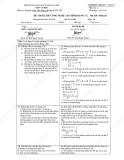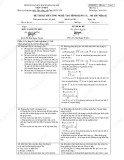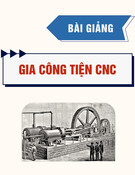
* Corresponding author
E-mail address: javid.ghahremani@yahoo.com (J. Ghahremani Nahr)
© 2019 by the authors; licensee Growing Science.
doi: 10.5267/j.uscm.2019.5.002
Uncertain Supply Chain Management 7 (2019) 599–618
Contents lists available at GrowingScience
Uncertain Supply Chain Management
homepage: www.GrowingScience.com/uscm
Meta-heuristics algorithm for two-machine no-wait flow-shop scheduling problem with
the effects of learning
Faramarz Nouria, Saeede Samadzada and Javid Ghahremani Nahra*
aFaculty member of Development and Planning Institute of ACECR, Iran
C H R O N I C L E A B S T R A C T
Article history:
Received April 6, 2019
Received in revised format May
10, 2019
Accepted May 18 2019
Available online
May 18 2019
In today’s world, due to rapid changes in the market, scheduling as one of the most fundamental
issues of competitive production, plays a very important role in maintaining the competitive
position and survival of manufacturing organizations, therefore, development of scheduling
models in order to improve the timing criteria is of great importance. In this research, we put
the development of a no-wait flow-shop scheduling model alongside with the effect of learning
into consideration to minimize the cost of consumption of resources. Finding the correct
sequence of two machines’ performance and optimized allocation of the resources for any
performance on each machine, were considered as the main goal in this study. To solve the
problem, metaheuristic genetic algorithms, particle swarm optimization, imperialist
competitive algorithms, optimization of the whale and the League Champions algorithms, have
been used. The statistical comparisons and also using of TOPSIS Multi-Criteria Decision
Making method, indicate high level of efficiency of the League Champions algorithm with the
utility weight of 0.9516.
., Canada
by
the authors; licensee Growin
g
Science2019 ©
Keywords:
Uninterrupted flow-shop
scheduling
Learning effect
Metaheuristic algorithms
Intermittent tasks
1. Introduction
Determining the program of priority and operation sequence in production planning issues, is one of
the most important key factors in each production department, since planning and scheduling of
production, prevents capital accumulation, reduces the waste, decrease or eliminates idle time of
machinery, and cause trying to make better use of them, optimizing energy consumption, timely
responsiveness to customer orders, and supplying raw materials and components at the right time.
Problems of scheduling largely varying and the purpose of production scheduling, is to allocate limited
resources to perform a set of activities over the time. Having an appropriate production scheduling
program, cause a decisive impact on increasing the productivity of the organization. The production
scheduling model in any manufacturing organization varies according to the goals and priorities of
access to each of them; as a consequence, to determine the appropriate scheduling model in the
organization, the goals, priorities and constraints on the resources must first be investigated. Operation
sequence and scheduling, are kind of decision-making processes have a key role to improve
productivity in manufacturing and service industries. In general, scheduling refers to the process of

600
allocating a limited number of resources to carry out a limited set of activities over the time, aimed to
optimize one or more performance criteria. From another point of view, it can be said that scheduling
is somehow dependent on decision-making and also is a process through which scheduling determined
and ultimately optimizes one or more goals and performance criteria. In most manufacturing systems
or information processing environments, scheduling acts as an important decision-making process
(Baker, 1974). Operation sequence is to determine the order of operation processing, and scheduling is
to decide on start and end time of the operation for available resources. In today’s competitive world,
having the best operation sequence and appropriate scheduling of activities, is a vital requirement for
companies to survive. According to Dempster (2012), scheduling defined as: “The art of allocating
resources to activities, ensuring that activities carried out in a reasonable time”. In practice, scheduling
is made using scheduling algorithms or knowledge-based rules.
In recent years, many researchers have been attracted to no-wait issues, and this interest mostly stems
from its application in the industry. A no-wait scheduling problem could occur in the production
environment, when all processing levels of a task from beginning to the end must be done on the
machines with no-wait and the processing steps carried out one after another without any delay. In
other words, the difference between the end and start time of any task in a no-wait production
environment, is equal to the total process time. Most industries such as: chemical and petrochemical,
steel, glassware and paper-related industries, encounter limitations in the production process
(Aldowaisan & Allahverdi, 2003). When the processing time of a task starts, the next steps have to be
carried out with no delay from one machine to another. Even in the case to start work from previous
step, its delay should go until the next processes start without any delay. This type of problems are so-
called "no-wait flow shop" or "zero expectation flow shop". One of the two main reasons of such
problems (no-wait) to occur in the production environments, refers to the nature of the processes and
technology employed (Choi et al., 2008). In some processes, in order to prevent undesirable changes
in temperature or other properties of materials (e.g. adhesion), it needs to do things in a continuous and
on-wait manner, otherwise will not get the desired results. Practicing this issue in the service industry
would only be justified, when cost of waiting time for the customers and service provider is too much.
Lack of storage between machineries or workstations is the second reason for no-wait environments to
appear (Chen et al., 2008). Apart from the mentioned examples above, we also encounter the problem
of just in time production systems or pull systems. In other words, when a flow of tasks performed
sequentially with no intermediate accumulation, there is a no-wait flow shop model in the system (Shao
et al., 2017). The problem of no-wait flow shop has been studied in recent decades. Various applications
of this issue in the industry, caused a lot of interest in researchers for modeling and providing solving
methods. For example, several articles dating back to the 70s, reviewed the computational complexity
of such issues. In recent years, most research on heuristics and meta-heuristics algorithms have been
proposed to solve this type of problems.
2. Review of Literature
Hall & Sriskandarajah (1996) conducted a comprehensive overview on no-wait scheduling issues and
presented some suggestions for future research. Allahverdi & Aldowaisan (2004) were the first
researchers, provided both hybrid simulated annealing algorithm and hybrid genetic algorithm, aimimg
at minimizing the maximum makespan and maximum delay for the no-wait flow shop problem.
Tavakkoli-Moghaddam et al. (2007) presented a hybrid artificial immune system algorithm to find
Pareto solutions for the no-wait flow shop problem with the objective functions of the total average
weight of the completion time of the tasks and the mean of delays total weight. Eren et al. (2008)
discussing the flow shop scheduling problem along with the learning effect, and also proved that their
model results in the optimal answer. Asadzadeh and Zamanifar (2010) suggested compound solution
approaches to solve no-wait flow shop problems and used genetic algorithms as a solution for the basic
flow shop scheduling problem. In a similar approach, Chen et al. (2012) used the Genetic Algorithm to
solve the sub-problem of allocating tasks to machines. There is a very limited research in the literature

F. Nouri et al. /Uncertain Supply Chain Management 7 (2019)
601
of scheduling with intermittent tasks, and papers mostly focused on single-machine and parallel
machines issues. Goldbogen et al. (2013) proposed a complex integer programming model for a two-
objective single-machine scheduling problem. They used the branch and bound method to solve large
and medium size problems. Vahedi-Nouri. (2013) developed the flowshop scheduling problem, taking
into account the same processing arrangement and learning effect. They first introduced their proposed
mathematic model and further developed it with its meta-heuristic algorithm. Laha and Gupta (2016)
examined the no-wait flowshop scheduling problem taking into account the minimization Makespan,
and initially modeled the problem with mathematical programming, and then improved it with the
Hungarian algorithm. He (2016) discussed the scheduling flowshop problem with the same processing
order, along with the learning effect to minimize the delay of the system, and improved it with the
branch and bound algorithm. Ye et al. (2016) examined no-wait flowshop scheduling problem to
maximize makespan, arguing that the problem is NP-hard in high volume, and then developed it with
an efficient algorithm. Ye et al. (2017) examined no-wait flowshop scheduling system problem to
minimize the completion time of the entire job, and developed the model using meta-heuristic
algorithm. Ultimately, they described the solutions in both large and small scales. Chen et al. (2017)
modeled the two-stage assembly flowshop scheduling problem with three machines to minimize
flowshop along with learning effect, and also used ant colony algorithm to optimize in large
dimensions. Shao et al. (2017) studied the no-wait flowshop problem and described the mathematical
model. They used the greedy search algorithm to solve the problem. Engin et al. (2018) examined the
no-wait flowshop problem and examined its mathematical model and improved it using ant meta-
heuristic algorithm. Li et al. (2018) examined the no-wait flowshop problem with regard to the time-
dependent preparation time and degradation effects. They used the local search algorithm to solve their
proposed model. Shahvari and Logendran (2018), in their research, addressed the flowshop scheduling
as a package with learning effect. In this study, first, they defined the mathematical model, and then
analyzed a two-stage hybrid algorithm to minimize the total sum of completion times and total delay
in the system. Gao et al. (2018) investigated no-wait flowshop scheduling problem in production paths
along with learning effects, and used the meta-heuristic neighborhood algorithm to solve this model.
Bai et al. (2018) examined the flowshop problem, taking into consideration the preparation time of the
job, along with the learning effect, and developed it using the branch and bound algorithm.
Given the review of the related literature as well as the necessity of using meta-heuristic algorithms in
solving flowshop scheduling problem, a mathematical model of no-wait flowshop scheduling problem
with learning effect is presented and the meta-heuristic algorithms i.e. genetics, particle swarm
optimization, whale optimization, colonial competition, and the League Champions algorithm were
used to solve the problem.
3. Modeling
In this part of the paper, statement of the problem and modeling of no-wait flowshop scheduling
problem, along with learning effect to minimize the cost of using resources are addressed. To do this,
we continue to define the sets, parameters, and decision variables for modeling the problem.
3.1. Sets
Job sets
,1,2,…,
machines set
1,2
Similar machine set 1,2,…,
3.2. Parameters
Normal process time of
on machine (processing without regard to resource allocation
and learning effect)
Allocated cost to the allocated resource
on machine

602
Learning factor due to learning
α,,, Fixed weight coefficients effective in processing operations
3.3. Decision variables
The actual process time of
on machine (considering the allocation of resources and
learning effect)
Completion time of
on machine
The position of
in the sequence of doing jobs
The amount of resources allocated to complete the job
on machine
The time for doing all joint jobs
The latest time to do the job
The earliest time to do the job
Makespan value
It takes 1, if the job
is assigned to the same machine and gets zero, otherwise.
It takes 1, if the job
is assigned to the same machine in the sequence of operations and
takes zero, otherwise.
It takes 1, if the job
is assigned to the operation and gets zero, otherwise.
Covariate variables to determine the optimal allocation of resources
Covariate variables to determine the optimal allocation of resources
In this problem, there are J independent job 1,2,…, to be processed continuously on two machines
1,2, each of which has similar machines 1,2,…,. For example, every job must first be
processed on the first machine and then on the second machine, and jobs are not allowed to wait
between two machines (there is no interruption). Also, all jobs are similarly available at zero time and
there is no preference for doing the jobs. The nonlinear mathematical model is presented according to
the set, parameters and decision variables as follows:
(1)
min
subject to
(2)
,∀
(3)
,∀
(4)
,∀
,
(5)
,min
,0,
(6)
∗
1,∀
,,
(7)
,∀
(8)
∗
,
1 1
, 2
,11
,
2

F. Nouri et al. /Uncertain Supply Chain Management 7 (2019)
603
(9)
,
1
1, 2
1,
(10)
,
1
1
,
,
1
(11)
,∀
,
(12)
,∀,
(13)
,∀
,,
(14)
, 1
,2
(15) ,
,
(16)
1,∀
(17)
,∀
,
(18)
max0,,∀
(19)
max0,,∀
(20)
,, ∈0,1,∀,
,
(21)
,,,,,,,,,,0, ∀
,,
(22)
,∀
Eq. (1) shows the value of the objective function of the model and aims to minimize the cost of using
resources by taking into account the learning effect in the correct sequence of operations in an
uninterrupted flowshop. Constraints (2) and (3) ensure that the waiting time between the two operations
is zero; there is no interruption in the other. Constraint (4) shows the actual processing time of each job
on each machine according to the available resources and the learning effect. Constraint (5) ensures
that there is an optimal sequence at which time all joint jobs are equal to the completion time of the
job. Constraint (6) shows the completion time of the jobs after the second machine operation. Constraint
(7) shows the makespan value. Constraint (8) shows the optimal allocation of resources for each job on
each machine according to the learning effect. Constraints (9) and (10) show the auxiliary variables
related to the optimal allocation of resources. Constraints (11) and (12) ensure that each job can only
be in a sequence of operations. Constraints (13) to (15) are covariate variables for problem solving.
Constraints (16) show that each job can only be assigned to a similar machine of type 1 and type 2
machines. Constraints (17) show the order of the sequence of each done task. Constraints (18) and (19)
calculate the earliest and latest time for each job. Constraints (20) to (22) express the type and gender
of the decision variables.
4. Problem solving method
This section outlines the foundations of the meta-heuristic algorithms used to solve the problem,
including genetic algorithm, particle swarm optimization algorithm, colonial competition algorithm,
whale optimization algorithm and League Champions algorithm.










![Đề thi Công nghệ tạo hình dụng cụ năm 2020-2021 - Đại học Bách Khoa Hà Nội (Đề 4) [Kèm đáp án]](https://cdn.tailieu.vn/images/document/thumbnail/2023/20230130/phuong62310/135x160/3451675040869.jpg)











![Bài tập môn Cơ sở thiết kế máy [năm] [mới nhất]](https://cdn.tailieu.vn/images/document/thumbnail/2025/20251008/ltgaming1192005@gmail.com/135x160/26601759980842.jpg)


![Tài liệu huấn luyện An toàn lao động ngành Hàn điện, Hàn hơi [chuẩn nhất]](https://cdn.tailieu.vn/images/document/thumbnail/2025/20250925/kimphuong1001/135x160/93631758785751.jpg)
